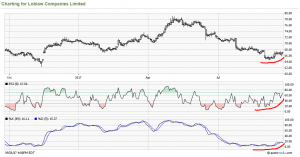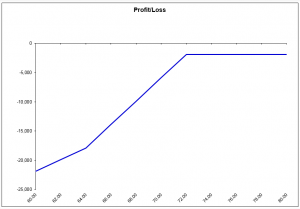A Repair Strategy for Loblaws Companies Limited stock

Daily graph of L ($67.11 on Tuesday, September 26, 2017)

As you can see in the above graph, the price of Loblaws Companies Limited (L) shares fell 18% from a peak of $78.85 on May 8, 2017, and then bottomed out at $64.65 on September 8, 2017. Since then, we have witnessed a tentative rebound that could suggest the worst is over. Of course, no one can say for sure. But in such case, investors who still hold the stocks could take advantage of the opportunity to implement a repair strategy that may allow them to recover some or all of the losses incurred, without the share price having to return to its May 8 high.
The Repair Strategy
The repair strategy involves purchasing one call option on the stock held while selling two call options on the same stock at higher strike prices than the call purchased. The purpose is to recover fully or in part the losses incurred without significantly increasing the existing risk. It is essentially equivalent to writing a covered call on the existing position while establishing a bull spread. This strategy allows us to double our potential gain in the event of an upswing without adding any significant downside risk.
Position
Suppose an investor was unlucky enough to purchase 1,000 L shares at $78.85 on May 8, 2017 and still holds the position as L stocks are trading at $67.11 at market close on September 26. The investor’s losses amount to $11,740 [($78.85 – $67.11) x 1,000 shares].
To implement a repair strategy, the investor could carry out the following trades:
- • Buy 10 call options, L 20180119 C 64, at $4.45 per share
- $4,450 debit
- • Sell 20 call options, L 20180119 C 72, at $0.70 per share
- $1,400 credit
- Total debit of $3,050
Profit and loss diagram

As you can see in the above graph, the strategy implemented does not permit to recover the total losses incurred. However, a rise in the stock price to $72 would bring the loss down to $1,900. Without the use of options, L would have to rally back to $76.95 ($78.85-$1.90) to achieve the same result. Furthermore, the risk of loss is only increased by the additional $3,050 debit. The disadvantage of this strategy is that potential gains are limited if the share price rises above the strike price of the call options sold. This should be taken into account before implementing a repair strategy.
Follow-up on the Position
Once the stock hits the strike price of $72, investors still have the option to re-evaluate whether it is worth retaining their stock. If so, they might consider rolling over their position by liquidating their existing options and establishing new ones at new strike prices.
Good luck with your trading, and have a good week!
The strategies presented in this blog are for information and training purposes only, and should not be interpreted as recommendations to buy or sell any security. As always, you should ensure that you are comfortable with the proposed scenarios and ready to assume all the risks before implementing an option strategy.
President
Monetis Financial Corporation
Martin Noël earned an MBA in Financial Services from UQÀM in 2003. That same year, he was awarded the Fellow of the Institute of Canadian Bankers and a Silver Medal for his remarkable efforts in the Professional Banking Program. Martin began his career in the derivatives field in 1983 as an options market maker for options, on the floor at the Montréal Exchange and for various brokerage firms. He later worked as an options specialist and then went on to become an independent trader. In 1996, Mr. Noël joined the Montréal Exchange as the options market manager, a role that saw him contributing to the development of the Canadian options market. In 2001, he helped found the Montréal Exchange’s Derivatives Institute, where he acted as an educational advisor. Since 2005, Martin has been an instructor at UQÀM, teaching a graduate course on derivatives. Since May 2009, he has dedicated himself full-time to his position as the president of CORPORATION FINANCIÈRE MONÉTIS, a professional trading and financial communications firm. Martin regularly assists with issues related to options at the Montréal Exchange.
The information provided on this website, including financial and economic data, quotes and any analysis or interpretation thereof, is provided solely for information purposes and shall not be construed in any jurisdiction as providing any advice or recommendation with respect to the purchase or sale of any derivative instrument, underlying security or any other financial instrument or as providing legal, accounting, tax, financial or investment advice. Bourse de Montréal Inc. recommends that you consult your own advisors in accordance with your needs before making decision to take into account your particular investment objectives, financial situation and individual needs.
All references on this website to specifications, rules and obligations concerning a product are subject to the rules, policies and procedures of Bourse de Montréal Inc. and its clearinghouse, the Canadian Derivatives Clearing Corporation, which prevail over the content of this website. Although care has been taken in the preparation of the documents published on this website, Bourse de Montréal Inc. and/or its affiliates do not guarantee the accuracy or completeness of the information published on this website and reserve the right to amend or review, at any time and without prior notice, the content of these documents. Neither Bourse de Montréal Inc. nor any of its affiliates, directors, officers, employees or agents shall be liable for any damages, losses or costs incurred as a result of any errors or omissions on this website or of the use of or reliance upon any information appearing on this website.
BAX®, CADC®, CGB®, CGF®, CGZ®, LGB®, MX®, OBX®, OGB®, OIS-MX®, ONX®, SCF®, SXA®, SXB®, SXF®, SXH®, SXM®, SXO®, SXY®, and USX® are registered trademarks of the Bourse. OBW™, OBY™, OBZ™, SXK™, SXJ™, SXU™, SXV™, Montréal Exchange and the Montréal Exchange logo are trademarks of the Bourse. All other trademarks used are the property of their respective owners.
© 2024 Bourse de Montréal Inc. All Rights Reserved.
